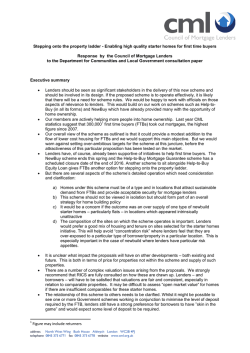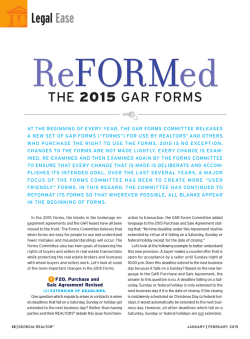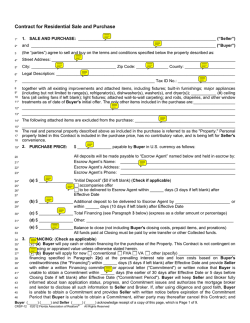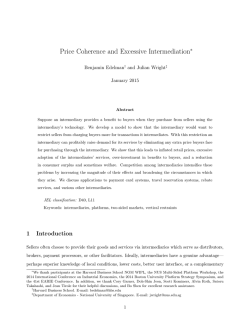
Economic Le er Se 1 Introduction
Dermot Coates, Reamonn Lydon & Yvonne McCarthy 1 Economic Letter Series House price volatility: The role of different buyer types Vol 2015, No. 2 Abstract This Economic Letter examines the link between house price dynamics in Ireland during the recent housing boom and the composition of buyers in the market. The analysis provides information on the relative riskiness of different buyer types, a topic that has increased in importance with the recent Central Bank of Ireland proposals to cap loan-to-value and loan-to-income ratios for new mortgage borrowings. The analysis points to an association between periods of strong house price growth and the changing composition of Irish property purchasers, and in particular, the rise in the BTL segment. 1 Introduction In the decade preceding the house price collapse in 2007, real Irish house prices grew by over 9 per cent per annum. Over this period, the structural make-up of buyers changed significantly, with first-time buyers (FTBs) accounting for a reducing share of transactions over time and buy-to-lets (BTLs) accounting for an increasing share. This raises the question of whether or not different buyer groups contribute differentially to house price dynamics. The relationship between different buyer types and house price volatility is particularly relevant in the context of recent proposals by 1 the Central Bank of Ireland to cap loan-tovalue (LTV) and loan-to-income (LTI) ratios on new mortgage lending. These proposals have highlighted a need to understand more about the relative riskiness of different buyer groups. In this context, Kelly et al (2014) find that FTBs have a lower default risk than second or subsequent buyers, implying that this could “rationalize differentiation of policy measures between different buyer groups”. This Economic Letter sheds further light on the issue of the relative riskiness of different buyers by examining the link between periods of rapid house price growth and the presence of different buyer groups in the Irish housing market. Corresponding author: [email protected]. The views expressed in this paper are those of the authors only and do not necessarily reflect the views of the Central Bank of Ireland. We thank Gerard O’Reilly, Gabriel Fagan, Rebecca Stuart and Mark Cassidy for helpful comments. House price volatility: The role of different buyer types Internationally, there is limited evidence on how the actions of different buyer groups such as new or existing owners/investors affect house price movements. This Economic Letter attempts to address this gap by examining the correlation between trends in the housing market and developments in the composition of mortgage borrowers over time. We find that periods of strong house price growth appear to be related more to the share of BTL borrowers in the market than to the share of FTBs. The next section summarises the key results. price growth expectations for a range of borrowers in 2005 and 2006. There is very little difference between the range of expectations (7 to 9 per cent) across the various groups. In particular, the “wants to buy” group, who could be considered to be a pool of potential FTBs, exhibit expectations which are not out of line with the expectations of other buyer groups. Thus, there does not appear to be any evidence in favour of this channel leading to heterogeneous effects on house prices from different buyer groups. 2 Figure 1: Price expectations (% annual growth) The Channels 9 In considering how different buyer groups might be expected to have a differential impact on house price dynamics, we identify three potential ‘channels’ and consider the evidence for Ireland: (i) the expectations channel; (ii) the liquidity channel and; (iii) the collateral channel. 8 Expected % Price Change over coming 12 Months 'FTB-pool' 2005 2006 7 6 5 4 3 2 1 Expectations channel A potential buyer’s current willingness to pay for a property may, in part, reflect their expectation regarding future price developments. Much of the recent literature on house prices highlights the role of expectations in driving house price dynamics, and in particular, periods of overvaluation. If buyer groups have different expectations regarding future price developments, their demand, and thus their impact on current house prices, should vary. In this vein, it could be argued that existing home owners or investors, who are active in the housing market, are better informed on house price developments and so have different expectations about the future, than potential new owners (FTBs). In a rising property market, if FTBs believe price growth will continue, while other buyer groups do not, they may purchase property now for fear that they will not afford it later. This would lead to a differential impact on house price growth relative to other buyers. Figure 1 shows the year-on-year house 0 Owner( >5 yrs) Owner (3-5 yrs) Owner (<=2 yrs) Wants to buy Doesn't own, not Wants to invest buying Source: ESRI-IIB Consumer Sentiment Survey Liquidity channel In a buoyant market, buyer affordability will fall if incomes do not grow in line with house prices (assuming no change in the supply of credit). In this situation, some buyer groups could find themselves ‘pricedout’ of the market. Again, there is a distinction between existing homeowners or investors and FTBs. The latter are generally younger, with lower levels of wealth and income, and have no existing housing wealth to draw on. This group, therefore, is more likely to get priced out of the market at a time when house prices are increasing rapidly. To examine this channel, and the ‘pricingout’ hypothesis in particular, we explore trends in ‘transaction rates’ for the different buyer groups over time. If a particular group of buyers is priced-out of the market, then one might 2 House price volatility: The role of different buyer types expect to see a reduction in the level of transactions carried out by this group when house prices are growing rapidly. We define a transaction rate for a particular group as the ratio of the number of mortgages drawn down for house purchase to the total population in that group. We proxy for the population of potential FTBs with the population aged 25 to 34 years. Similarly for the next-time buyer (NTB) and BTL group, we use the population aged 35 - 49 years.2 during the peak years of the boom from 2000 through to 2007, suggests that potential FTB buyers were not priced out of the market. The starkest result is the trend in the transaction rate for NTBs and BTLs, which rises rapidly from 2001 onwards. As we show in the next section, the main driver of this trend was the rapid increase in BTL transactions, which rose from less than 5 per cent of the market to account for more than a quarter of all transactions for house purchases at the peak of the housing cycle. Figure 2: Transaction rates Transaction rates for FTB and NTB+BTL borrowers 9 9 8 7 8 Next-time buyers (NTB) + Buy-to-let (BTL) 6 7 6 5 5 First-time buyers(FTB) 4 4 3 3 2 2 1 1 0 0 1996 1997 1998 1999 2000 2001 2002 2003 2004 2005 2006 Source: Central Bank calculations Figure 2 shows the trends in transaction rates over time. Following a drop in the mid- to late-1990s, the FTB transaction rate remained steady at around 5 per cent of the population in the 25-34 age group. As a further check. we also examine the home-ownership rate for those in the 25-34 year age group using Household Budget Survey data from the CSO; while the rate declined from 65 per cent in 1994 to 58 per cent in 1999, it remained relatively stable thereafter until the housing bust in 2007. Overall, the fact that the FTB transaction and home-ownership rates remained steady Collateral channel Another way in which buyers might have differential impacts on house price dynamics relates to housing equity.3 In a rising housing market, existing homeowners benefit from an increase in their housing collateral. This capital gain increases their ability to purchase a new property (as their down-payment constraint has been eased), and thus the price of properties for NTBs increases. The increase in the price of NTB properties leads to further capital gains in this market and so demand in the NTB market increases further. As this positive feedback loop continues, it can lead to price overshooting, i.e. house prices increase beyond a level justified by fundamentals.4 If the collateral channel operates, one would expect to observe an increase in the share of existing homeowners in housing transactions when house prices rise. Furthermore, since the additional demand from capital gains originates with NTBs, and since NTBs and FTBs generally demand different types of properties (the latter group tending to demand 2 The choice of the potential pool of each group is informed by our analysis of the characteristics of borrowers from mortgage loan-level data at the CBI; we observe that the median age of FTBs between 2000 and 2006 was 32 years while the median age for NTB and BTL borrowers was 39 and 42 years respectively. 3 This channel is distinct from the liquidity channel; the latter hypothesises that certain buyers are priced out of the market because their affordability cannot keep up with house price increases. The collateral channel, on the other hand, does not suggest that buyers get priced out of the market, but rather that the group of existing homeowners, who experience capital gains (losses) during housing upturns (downturns) disproportionately impact house price developments. 4 For further information on this channel, and a more formal model of housing demand with down-payment constraints, see Stein (1995) and Ortalo-Magn´e (2006). 3 House price volatility: The role of different buyer types ‘starter’ homes, for example), one should observe a difference in the rate of inflation among FTB and NTB properties. We examine each of these issues in Figures 3 and 4 below. growth rate of house prices for first-time versus second-time buyers. Benito (2006) finds a similar result for the UK, albeit with marginally higher growth for NTBs during the late 1980s. Figure 3: Share of mortgage loans for purchase Figure 4: House price trends (FTB versus NTB) 160 70% 140 60% 120 Next-time buyer 50% 40% 160 FTB STB 140 140 120 120 100 100 80 80 60 60 40 40 20 20 100 FTB 80 30% 60 20% 40 10% 20 BTL 0 1996 1996 1997 1998 1999 1999 2000 2001 2002 2002 2003 2004 2005 2005 2006 2007 2008 2008 2009 2010 2011 2011 2012 2013 2014 0% Buy-to-let First-time buyer Next-time buyer House Prices (real, rhs 2005=100) 0 2003Q1 0 2004Q1 2005Q1 2006Q1 2007Q1 2008Q1 2009Q1 Source: Central Bank calculations Source: DoELG and IBPF Figure 3 shows that the FTB share declined from 40 per cent to 33 per cent during the early 2000s as house prices rose rapidly. However, this was largely due to the marked increase in BTL transactions during this period. Indeed, if BTL loans are excluded, there is little change in the FTB share throughout the boom. This is not necessarily a rejection of the collateral channel, as Lydon and O’Hanlon (2012) show that many existing home owners realised their capital gain via equity withdrawal which was used to purchase additional property, as opposed to selling their existing home. The observed negative correlation between house price growth and FTB shares is not unique to Ireland. As we show in Figure A6 in the appendix, similar patterns are observed in Australia, the US and UK.5 Next we compare house price inflation for FTB and NTB properties (Figure 4). The chart shows little difference in the average One possible explanation of this finding could be the presence of buy-to-let buyers in the Irish market. The expectation of greater inflation in the NTB market assumes that FTB- and NTB-type properties are not substitutable. In Ireland, however, buy-to-let borrowers were active in acquiring both FTB and NTB properties during the boom, as indicated by the average price of properties purchased by investors (e250,000) which sat at the midway point between FTB (e230,000) and NTB (e280,000) properties. Thus, whilst we may observe a collateral effect driving up NTB and BTL demand, we may not observe differential levels of house price growth between FTB and NTB purchases. One corollary of this is that we would expect to see a positive correlation between excessive house price developments (i.e. over- or under-shooting) and the share of BTLs in the market. Figure 5 shows that this is indeed the case: using a standard house price model to 5 We also tested the significance of this negative correlation in a regression of house price growth on the log of the FTB share, controlling for disposable income and country fixed effects: the coefficient is -0.21, with a standard error of 0.063. 6 House price mis-alignment is calculated as the difference between actual and fundamental house prices. The fundamental house price is estimated with a standard reduced form model of house prices, where prices are a function of income levels, real interest rates, population levels and the total housing stock. For a more thorough overview of the model, see Kennedy and McQuinn (2012) 4 House price volatility: The role of different buyer types measure house price ‘mis-alignment’, we find a strong correlation between this mis-alignment and the increasing presence of BTL buyers in the Irish housing market.6 Figure 5: House price mis-alignment and BTL 40 0.35 30 0.3 20 0.25 10 0.2 0 0.15 -10 0.1 -20 0.05 -30 1996Q1 1998Q1 2000Q1 2002Q1 2004Q1 2006Q1 2008Q1 HP mis-alignment BTL market share Percent mis-alignment from fundamental HP share 0 BTL Market Share (rhs) Source:Central Bank calculations 3 Conclusion This Economic Letter examines the link between house prices and the composition of buyers in the Irish housing market, with a particular focus on the recent housing boom. We hypothesise three channels through which different buyers might have varying impacts on house price growth; the expectations channel; the liquidity channel and the collateral channel. In terms of the first two channels, we find no evidence that buyers in the Irish market had varying impacts on house prices through these channels. We do, however, observe a number of stylised facts in the data which are consistent with the operation of the collateral channel. Specifically, we find that during periods of strong house price appreciation, the share of FTBs in the market fell, while other buyers, and in particular BTLs, became increasingly important. We also find that the share of BTLs in the market is positively correlated with a measure of overvaluation in the market, a result which does not hold for other buyer groups. While a more formal investigation is necessary to define causal relationships between house prices and different buyer groups, we nonetheless observe an interesting association between the period of excessive house price growth observed in Ireland until the house price collapse in 2007, and the changing composition of Irish property purchasers, and in particular, the rise in the BTL segment.7 These findings, therefore, are informative when considering the relative riskiness of different buyer segments, from the perspective of their relationship with periods of excessive house price growth. References [1] Benito, A. (2006). “How does the down-payment constraint affect the UK housing market?”, Working Paper No. 294, Bank of England. [2] CBI (2014). “Macro-prudential policy for residential mortgage lending”, Consultation Paper CP87, Central Bank of Ireland. [3] Kelly, R., O’Malley, T. and C. O’Toole (2014). “Do first time buyers default less? Implications for macro-prudential policy” Economic Letters 14/EL/14, Central Bank of Ireland. 7 In terms of a more formal validatiin of the predictions of the Stein (1995) and Ortalo-Magn´e (2006) models of housing demand with downpayment constraints, an analysis of the extent to which existing owners used housing equity to invest in BTL properties, as suggested in Lydon and O’Hanlon, would be particularly useful. 5 House price volatility: The role of different buyer types [4] Kennedy, G. and K. McQuinn (2012). “Why are Irish house prices still falling?” Economic Letters 5/EL/12, Central Bank of Ireland. [5] Lydon, R and N. O’Hanlon (2012). “Housing equity withdrawal, property bubbles and consumption”. Journal of the Statistical and Social Enquiry of Ireland, Vol. XLI. [6] Ortalo-Magn´e, F. and S. Rady (2006). “Housing market dynamics: On the contribution of income shocks and credit constraints”, The Review of Economic Studies, Vol. 73, No.2, pp. 459-485. [7] Stein, J. (1995), “Prices and trading volume in the housing market: a model with downpayment effects”, Quarterly Journal of Economics, 110, pp. 379-406. Figure 6: FTB share and house prices House price index and FTB share FTB Share HP index 25 80 20 60 15 40 10 20 5 0 0 50 0 2000 2002 2004 2006 2008 2010 2012 2014 FTB Share HP index 40 30 20 10 0 2000 2002 2004 2006 2008 2010 2012 2014 FTB share 150 House prices 50 FTB Share House prices Ireland 80 60 100 40 50 FTB Share United Kingdom 120 100 80 60 40 20 0 60 50 40 30 20 10 0 100 2000 2002 2004 2006 2008 2010 2012 2014 HP index FTB Share 150 House prices 30 100 House prices 120 FTB Share HP index United States FTB Share Australia 20 0 0 1996 1999 2002 2005 2008 2011 2014 Source: National sources, BIS Residential Property Price database (www.bis.org/statistics) 6
© Copyright 2024







